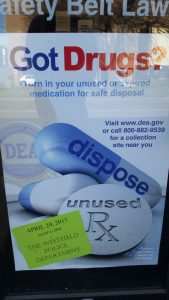WESTFIELD–The city’s police department is giving residents another opportunity to properly dispose of unused drugs, including addictive substances like opiates, later this month.
The Westfield Police Department will be having a drug take-back day on Saturday, April 29, from 10 a.m. until 2 p.m., at the department headquarters on Washington Street. The program is done in conjunction with the city of Westfield’s Health Department, as well as the Drug Enforcement Agency (DEA), the latter of which helps with the proper disposal of the medications.
“The drug take-back provides a logical and safe place to dispose of medications,” Westfield Police Capt. Michael McCabe, said.
The take-back program, in addition to removing medication that could pose a possible harm if it were to get into water systems through dumping it down drains or if someone accidentally ingested it, also takes the possibility of drugs like opiates and other drugs of abuse from ending up in the hands of people other than the patients to whom the medications were prescribed.
“It’s a good program to dispose of drugs relatively safely and it removes a possibility for use of abuse,” McCabe said.
If the date and time does not work for someone looking to properly dispose of medications, then McCabe said that there is a storage bin inside the police station lobby that is accessible 24 hours a day, seven days a week, that you can put unwanted medication in. He added that there will be no questions asked when medications are given to police.
According to Environmental Protection Agency (EPA) guidelines, proper medication disposal should occur at drug take-back programs, or otherwise must be properly discarded via steps that can be found on the EPA’s web site. However, the EPA urges to never dispose of medication down a toilet or drain unless “the label or accompanying patient information specifically instructs you to do so,” according to the EPA handout on proper medication disposal.
These guidelines are put forth to reduce the amount of medications that can end up in water systems, according to the EPA handout.


